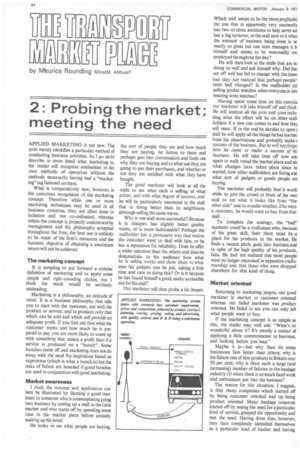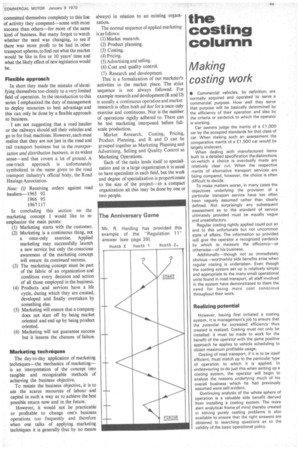: Probing the market; meeting the need
Page 50

Page 51

If you've noticed an error in this article please click here to report it so we can fix it.
APPLIED MARKETING is not new. The term merely identifies a particular method cf conducting business activities. As I go onto describe in more detail what marketing is, the reader will recognize similarities in his own methods of operation without the methods necessarily having had a "marketing" tag fastened on them.
What is comparatively new, however, is the conscious recognition of the marketing concept. Therefore while one or more marketing techniques may be used in all business concerns, they are often done in isolation and not co-ordinated, whereas unless the concept is properly understood by management and the philosophy accepted throughout the firm, the best use is unlikely to be made of the firm's resources and the business objective of obtaining a maximum return will not be achieved.
The marketing concept It is tempting to put forward a concise definition of marketing and to apply some simple and right-sounding cliches, but I think the result would be seriously misleading.
Marketing is a philosophy, an attitude cf mind. It is a business philosophy that tells you to start with the customer, not with the product or service, and to produce only that which can be sold and which will provide an adequate profit. If you find out first what the customer wants and how much he is prepared to pay you are more likely to come up with something that makes a profit than if a service is produced on a "hunch". Some hunches come off and marketing does not do away with the need for inspiration based on experience (which is what a hunch is) but the risks of failure are lessened if good hunches are used in conjunction with good marketing.
Market awareness I think the concept and application can best be illustrated by likening a good marketer to someone who is contemplating going into business by setting up a stall in the local market and who starts off by spending some time in the market place before actually making up his mind.
He looks to see what people are buying, the sort of people they are and how much they are paying; he listens to them and perhaps gets into conversation and finds out why they are buying and to what use they are going to put their purchases, and whether or not they are satisfied with what they have bought.
The good marketer will look at all the stalls to see what each is selling, at what prices, and with what degree of success, and he will be particularly interested in the stall that is doing better than its neighbours although selling the same wares.
Why is one stall more successful? Because it is cheaper, has slightly better quality wares, or is more fashionable? Perhaps the stallholder has a persuasive way that makes the customer want to deal with him, or he has a reputation for reliability. Does he offer a wider selection than the others and does he demonstrate to his audience how what he is selling works and show them to what uses his gadgets can be put, taking a little time and care in doing this? Or is it because he has found himself a good, easily accessible site for his stall?
Our marketer will then probe a bit deeper.
Which stall seems to be the moreprojitabh the one that is apparently very successfu has two or three assistants to help serve an has a big turnover, or the stall next to it whet the amount of business being done is nc nearly so great but one man manages it b himself and seems to be reasonably we employed throughout the day?
He will then look at the stalls that are nc doing so well and ask himself why. Did the; set off well but fail to change with the timet had they not realized that perhaps people': taste had changed? Is the stallholder stil selling pocket watches when everyone is nos wearing wrist watches?
Having spent some time on this exercisi our marketer will take himself off and think He will analyse all the pros and cons including what the effect will be on other stall holders if a new one comes in and how the) will react. If in the end he decides to open stall he will apply all the things he has learnec from his observations and probably make a success of the business. But he will not forgo how he came to make a success of hi: business. He will take time off now anc again to walk round the market place and sec what changes have taken place since hr started, how other stallholders are faring and what sort of gadgets or goods people art buying.
The marketer will probably find it worth while to join the crowd in front of his own stall to see what it looks like from "the other side" and to wonder whether, if he were a customer, he would want to buy from that stall . . .
To complete the analogy, the "bad" marketer could be a craftsman who, because of his great skill, feels there must be a place for his products in the market. He finds a vacant pitch, goes into business and in spite of the high quality of his products, fails. He had not realized that most people were no longer interested in expensive craftsmanship and that those who were shopped elsewhere for that kind of thing.
Market oriented Returning to marketing jargon, our good marketer is market or customer oriented whereas our failed marketer was product oriented. He failed to see you can only sell what people want to buy.
If the marketing concept is as simple as this, the reader may well ask: "What's so wonderful about it? It's merely a matter of applying a little commonsense to business, and looking before you leap."
Maybe it is—but why then do some businesses fare better than others; why is the failure rate of new products in Britain over 50 per cent; why is there such a large (and increasing) number of failures in the haulage industry (i) when there is so much hard work and enthusiasm put into the business?
The reason for this situation, I suggest, is that many companies which started off by being customer oriented end up being product oriented. Many haulage concerns started off by seeing the need for a particular kind of service, grasped the opportunity and met the need. Having done that, however, they then completely identified themselves as a particular kind of haulier and having
committed themselves completely to this line of activity they competed—some with more success than others—for more of the same kind of business. But many forgot to watch whether the need was changing, to see if there was more profit to be had in other transport spheres, to find out what the market would be like in five or 10 years' time and what the likely effect of new legislation would be.
Flexible approach
In short they made the mistake of identifying themselves too closely to a very limited field of operation. In the introduction to this series I emphasized the duty of management to deploy resources to best advantage and this can only be done by a flexible approach to business.
I am not suggesting that a road haulier or the railways should sell their vehicles and go in for fruit machines. However, each must realize that they are not just in the road and rail transport business but in the transportation and distribution business, in its widest sense—and that covers a lot of ground. A one-track approach is unfortunately symbolized in the name given to the road transport industry's official body, the Road Haulage Association.
Note: (0 Receiving orders against road hauliers-1965 92
1966 95 1967 117 In concluding this section on the marketing concept I would like to reemphasize the main points: (1) Marketing starts with the customer.
(2) Marketing is a continuous thing, not a once-only exercise. Applied marketing may successfully launch a new service but only the conscious awareness of the marketing concept will ensure its continued success.
(3) The marketing concept must be part of the fabric of an organization and condition every decision and action of all those employed in the business.
(4) Products and services have a life cycle, during which they are created, developed and finally overtaken by something else.
(5) Marketing will ensure that a company does not start off by being market oriented and end up by being product oriented.
(6) Marketing will not guarantee success but it lessens the chances of failure.
Marketing techniques
The day-to-day application of marketing techniques—the mechanics of marketing— is an interpretation of the concept into tangible and recognizable methods of achieving the business objective.
To restate the business objective, it is to use the scarce resources of labour and capital in such a way as to achieve the best possible return now and in the future.
However, it would not be practicable or profitable to change one's business operations too frequently and therefore when one talks of applying marketing techniques it is generally (but by no means always) in relation to an existing organization.
The normal sequence of applied marketing is as follows: (1) Market research.
(2) Product planning.
(3) Costing.
(4) Pricing.
(5) Advertising and selling.
(6) Cost and quality control.
(7) Research and development.
This is a formalization of our marketer's activities in the market place. The strict sequence is not always followed. For example research and development (R. and D) is usually a continuous operation and market research is often both ad hoc for a once-only exercise and continuous. Nor is the number of operations rigidly adhered to. There can be test marketing interposed before fullscale production.
Market Research, Costing, Pricing, Product Planning, and R and D can be grouped together as Marketing Planning and Advertising, Selling and Quality Control as Marketing Operations.
Each of the tasks lends itself to specialization and in a large organization it is usual to have specialists in each field, but the work and degree of specialization is proportionate to the size of the project—in a compact organization all this may be done by one or two people.








































































































